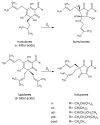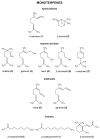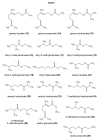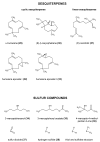Effects of Dry-Hopping on Beer Chemistry and Sensory Properties-A Review
- PMID: 37764422
- PMCID: PMC10534726
- DOI: 10.3390/molecules28186648
Effects of Dry-Hopping on Beer Chemistry and Sensory Properties-A Review
Abstract
Dry-hopping is the addition of hops to the wort on the cold side of the brewing process. Unlike standard hop additions, its main purpose is not to produce a characteristic bitterness but to extract as much of the hop essential oils as possible, which are largely lost in the standard hopping process. When dry-hopped, it is possible to obtain a beer with an aroma that is difficult to achieve when hops are used on the hot side of the brewing process. As a result, this process has become very popular in recent years, particularly in beers that belong to the 'craft beer revolution' trend. In addition, the usefulness of this process is increasing with the development of new hop varieties with unique aromas. This article presents the main components of hops, focusing on those extracted during the process. Changes in the composition of beer bittering compounds and essential oils resulting from this process are discussed. This paper presents the current state of the knowledge on the factors affecting the degree of extraction, such as hop dosage, the time, and temperature of the process. Issues such as process-related physicochemical changes, hop creep, low flavor stability, haze formation, and green flavor are also discussed.
Keywords: beer; dry-hopping; essential oils; hop creep; hop resins.
Conflict of interest statement
The authors declare no conflict of interest.
Figures




Similar articles
-
Interesting Behavior of Geranic Acid during the Beer Brewing Process: Why Could Geranic Acid Remain at a Higher Level Only in the Beer Using Sorachi Ace Hops?J Agric Food Chem. 2023 Nov 29;71(47):18489-18498. doi: 10.1021/acs.jafc.3c04740. Epub 2023 Nov 14. J Agric Food Chem. 2023. PMID: 37962414
-
Impact of Hop Freshness on Dry Hopped Beer Quality.Foods. 2022 Apr 30;11(9):1310. doi: 10.3390/foods11091310. Foods. 2022. PMID: 35564033 Free PMC article.
-
The Impact of Hop Freshness on Kettle-Hopped Beers.Foods. 2023 Dec 2;12(23):4353. doi: 10.3390/foods12234353. Foods. 2023. PMID: 38231846 Free PMC article.
-
Chemical transformations of characteristic hop secondary metabolites in relation to beer properties and the brewing process: a review.Food Chem. 2015 Apr 1;172:742-56. doi: 10.1016/j.foodchem.2014.09.139. Epub 2014 Oct 2. Food Chem. 2015. PMID: 25442616 Review.
-
Humulus lupulus and microbes: Exploring biotic causes for hop creep.Food Microbiol. 2023 Sep;114:104298. doi: 10.1016/j.fm.2023.104298. Epub 2023 May 10. Food Microbiol. 2023. PMID: 37290874 Review.
Cited by
-
Si-based agent alleviated small bowel ischemia-reperfusion injury through antioxidant effects.Sci Rep. 2024 Feb 20;14(1):4141. doi: 10.1038/s41598-024-54542-7. Sci Rep. 2024. PMID: 38374376 Free PMC article.
-
GC-MS and Sensory Analysis of Aqueous Extracts of Monovarietal American Hops, Produced Using the Synergy Pure™ Extraction Technique.Foods. 2024 Aug 3;13(15):2454. doi: 10.3390/foods13152454. Foods. 2024. PMID: 39123645 Free PMC article.
References
-
- Lafontaine S.R., Shellhammer T.H. Impact of static dry-hopping rate on the sensory and analytical profiles of beer. J. Inst. Brew. 2018;124:434–442. doi: 10.1002/jib.517. - DOI
-
- Praet T., van Opstaele F., Baert J., Aerts G., de Cooman L. Comprehensive characterisation of the hop-derived sesquiterpenoid fingerprint of American kettle hopped lager beers. Brew. Sci. 2014;67:187–194.
-
- Schönberger C., Kostelecky T. 125th Anniversary review: The role of hops in brewing. J. Inst. Brew. 2011;117:259–267. doi: 10.1002/j.2050-0416.2011.tb00471.x. - DOI
-
- Steele M. IPA: Brewing Techniques, Recipes, and the Evolution of India Pale Ale. Brewers Publications; Boulder, CO, USA: 2012.
-
- Sterowski R. Did Hodgson Invent Dry Hopping? 2010. [(accessed on 14 August 2023)]. Available online: https://refreshingbeer.blogspot.com/2010/01/did-hodgson-invent-dry-hoppi....
Publication types
LinkOut - more resources
Full Text Sources
Research Materials

